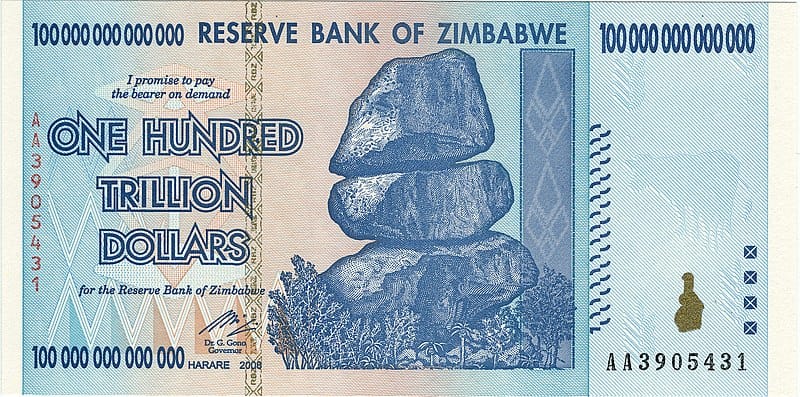
89.7 Sextillion Percent: Zimbabwe and Inflation
Published 22 Jul, 2024
Inflation is only sexy when everyone is paying attention, and by that time it is too, too late. Until that time, inflation must compete with political intrigue, sport, celebrity gossip, and, well, daily life.
At least part of Truflation's charter is to educate. This means making us better consumers of information. In turn, we must study history. It's not always a straight line from example to example, but outrages happen and though they're horrible for the people experiencing them we can honor their troubles by not repeating such missteps.
As such things go, Zimbabwe is a hum dinger.
READ Inflation's Defining Role in the American Revolution

Zimbabwe's hyperinflation remains one of the most extreme cases of economic mismanagement in history, reflecting the catastrophic consequences of flawed monetary policies, corruption, and political instability. This inflationary period, which reached its zenith in the late 2000s, offers a stark example of how poor governance can devastate an economy.
The roots of Zimbabwe's hyperinflation can be traced back to several interlinked factors:
- Land Reform Policies: In the early 2000s, President Robert Mugabe's government initiated a controversial land reform program aimed at redistributing land from white commercial farmers to black Zimbabweans. This policy, although well-intentioned, was executed chaotically and often violently. The sudden disruption in agricultural production, a backbone of the economy, led to a significant decline in food output and export revenues.
- Economic Mismanagement and Corruption: The Zimbabwean government's economic policies during this period were marked by extensive corruption and mismanagement. The lack of accountability and transparency in the government exacerbated the economic crisis, as funds were often diverted from productive uses to serve the interests of the political elite.
- Excessive Money Printing: In response to the declining economy and growing fiscal deficits, the Reserve Bank of Zimbabwe (RBZ) resorted to printing money at an alarming rate. This was intended to finance the government's expenditures, including public sector wages and social programs, but it led to an oversupply of money in the economy, drastically reducing the value of the Zimbabwean dollar.
- Sanctions and International Isolation: Zimbabwe faced economic sanctions from Western nations due to human rights abuses and political repression under Mugabe's regime. These sanctions further isolated Zimbabwe from international financial systems and foreign aid, exacerbating the economic crisis.
READ US Presidential Administrations and Their Impact on Inflation
The impact of hyperinflation on Zimbabwe was devastating:
- Erosion of Savings and Investments: Hyperinflation wiped out the savings of ordinary Zimbabweans, as the value of the Zimbabwean dollar plummeted. People’s lifetime savings became worthless, and the real value of wages eroded rapidly.
- Unemployment and Poverty: The economic collapse led to widespread unemployment and poverty. Industries shut down, and many businesses could not operate in such an unstable economic environment. Unemployment rates soared, pushing millions into poverty.
- Decline in Public Services: The government struggled to provide basic services such as healthcare and education. Hospitals ran out of essential supplies, and schools could not afford to stay open. The quality of life for the average Zimbabwean deteriorated significantly.
- Social and Political Unrest: The economic crisis led to social unrest and political instability. Protests and strikes became common as people demanded better living conditions and accountability from their leaders.
Zimbabwe’s hyperinflation reached an astonishing peak. In November 2008, Zimbabwe’s annual inflation rate was estimated at 89.7 sextillion percent (89,700,000,000,000,000,000,000%) by the Cato Institute. The country stopped reporting official inflation statistics after July 2008 when it had reached 231,150,888.87%. At its height, prices doubled approximately every 24 hours.
The Consumer Price Index (CPI) provides a clear illustration of this hyperinflation. In January 2008, the CPI was 100,000. By November of the same year, it had surged to an unimaginable 516 quintillion. This meant that the cost of goods and services increased by an almost inconceivable factor in less than a year.
READ Israel Responds to Iran: War and Inflation in the 21st Century
President Robert Mugabe was the central figure during this period of hyperinflation. Mugabe, who had been in power since Zimbabwe’s independence in 1980, maintained a tight grip on the country’s political landscape. Under his leadership, the government’s economic policies, including the disastrous land reform and the decision to print money recklessly, directly contributed to the hyperinflation crisis.
Gideon Gono, the Governor of the Reserve Bank of Zimbabwe from 2003 to 2013, also played a pivotal role. Gono was responsible for implementing the monetary policies that led to the excessive printing of money. His tenure at the RBZ is often criticized for exacerbating the hyperinflation and failing to stabilize the economy.
The hyperinflation of Zimbabwe stands as a testament to the catastrophic effects of poor economic management and political misgovernance. The causes were multifaceted, stemming from disruptive land reforms, economic mismanagement, rampant corruption, and isolation from the international community. The impact was severe, plunging millions into poverty and leading to a near-collapse of the nation's economy. Understanding this period is crucial for policymakers worldwide to avoid similar economic pitfalls.
Website | X | Discord | Telegram | Github | YouTube
Get Exclusive Insights
with our Weekly Newsletter